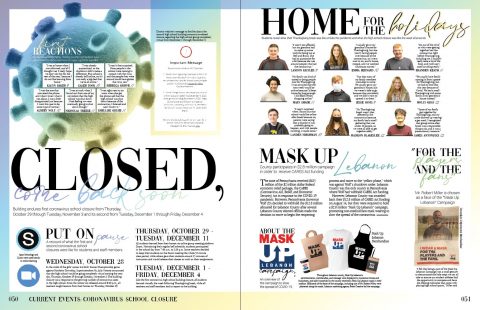We’re bombarded with news stories every single day, and as scholastic journalists it can be difficult to know how to cover these events properly. We reached out to the yearbook program at Eastern Lebanon County High School in Myerstown, Pennsylvania, for input from two of its members. This article is by Lucy Bickel. Be sure to check out the other article by Jon Bickel, her adviser and father.
Being a yearbook editor in a school district with graduating classes of around 180 students in the politically divided, purple state of Pennsylvania, I definitely get the walking-on-eggshells feeling when it comes to designing showstopper spreads that cover current events. From polarizing politics to TikTok trends to our school’s highly debated dress code, I’ve created spreads that cover a wide range of topics that students in my community have distinct opinions on. My main goal in creating a spread on a controversial topic is to stay objective, find the facts and carry that neutrality into my spreads while still being representative of my student body’s opinions.
The Fact is, I Use Fact-Checking
As soon as I decide what contentious topic I want to cover, I must first research what really happened during that event or in that issue. I avoid news sources that have a bias and check a variety of local and national sources. As a yearbooker and journalist myself, I believe that the cardinal rule of effective journalism is to expose the truth, and the easiest way to do that is to have reputable, accurate sources and information. Now that I have all the facts, I can craft a spread that is objective and accurate in its coverage.
Survey Central
After I’ve researched the ins and outs of the topic I’m covering, I create a survey of thoughtful questions. As soon as my survey is approved by both my adviser and my principal, I will hand it out to about 50-100 students across all grade levels, which is a nice size representation of my small school. In my surveys, I include a mix of multiple choice and yes or no questions, of which the data is perfect for pie charts and graphs. Additionally, I include some open-ended questions in my surveys. These that I receive from the students are candid quotes that dig deeper into the topic. After I’ve received the data from my survey, I begin my quest for photos on the controversial subject.
Creative Commons is my Best Friend
With my survey data in hand, I then plant myself in front of my iMac and head to Creative Commons to look up copyright-safe images for my spread. When looking for photos to use for my current events spread, I try to include photos that are representative of the whole topic. This is especially important when dealing with politics, so I include figures from both parties to make sure everyone’s beliefs are represented. Once I find the perfect images, I place them on my blank spread and give proper credit to the photographer. Now that I’m in the clear of copyright infringement, I can begin the fun stuff: designing my showstopper spread!
My Date with Adobe InDesign
Next, I sit at my iMac and design for hours at a time, only straying from my yearbook page for a quick snack break! Now that I have my credible news sources, informative survey responses and Creative Commons photos, I have all the tools I need to design my spread. I usually have a vague idea of what I want the spread to look like before I design it, but in the end, my designs usually center around what photos and information I have. After a good four-to-five hours of designing, I look up at my computer screen and voilà! a bias-free, objective spread rests in front of my eyes that is both visually appealing and representative of my student body at the same time.
To avoid my own potential bias (we all have some), it’s important to make sure other people on staff review my work as well to make sure it is a strong design with objective coverage.
At the end of the day, the best way to approach a controversial topic is to accurately represent your student body’s opinions. When you hand out your yearbook at the end of the school year, you’ll have the satisfaction that you’re handing out the truth to your fellow students.




